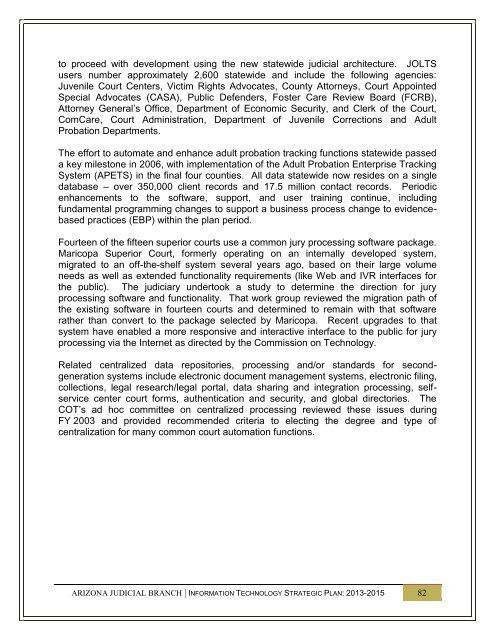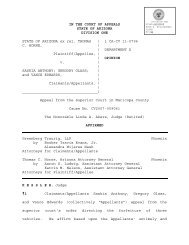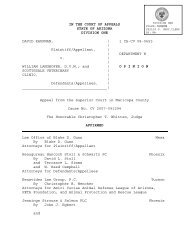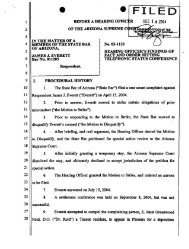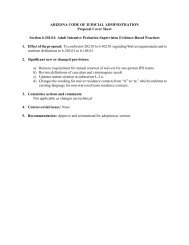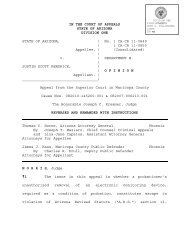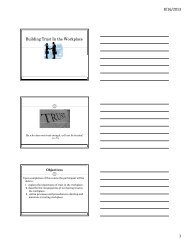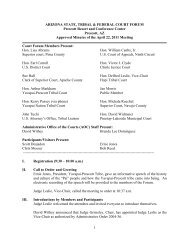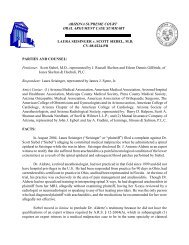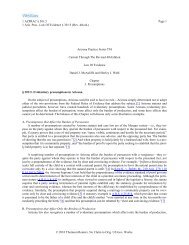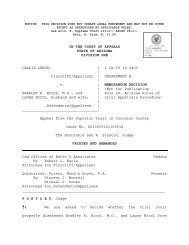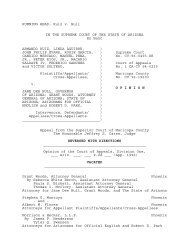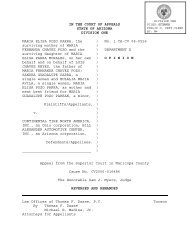Print Version - Arizona Judicial Department
Print Version - Arizona Judicial Department
Print Version - Arizona Judicial Department
You also want an ePaper? Increase the reach of your titles
YUMPU automatically turns print PDFs into web optimized ePapers that Google loves.
to proceed with development using the new statewide judicial architecture. JOLTS<br />
users number approximately 2,600 statewide and include the following agencies:<br />
Juvenile Court Centers, Victim Rights Advocates, County Attorneys, Court Appointed<br />
Special Advocates (CASA), Public Defenders, Foster Care Review Board (FCRB),<br />
Attorney General’s Office, <strong>Department</strong> of Economic Security, and Clerk of the Court,<br />
ComCare, Court Administration, <strong>Department</strong> of Juvenile Corrections and Adult<br />
Probation <strong>Department</strong>s.<br />
The effort to automate and enhance adult probation tracking functions statewide passed<br />
a key milestone in 2006, with implementation of the Adult Probation Enterprise Tracking<br />
System (APETS) in the final four counties. All data statewide now resides on a single<br />
database – over 350,000 client records and 17.5 million contact records. Periodic<br />
enhancements to the software, support, and user training continue, including<br />
fundamental programming changes to support a business process change to evidencebased<br />
practices (EBP) within the plan period.<br />
Fourteen of the fifteen superior courts use a common jury processing software package.<br />
Maricopa Superior Court, formerly operating on an internally developed system,<br />
migrated to an off-the-shelf system several years ago, based on their large volume<br />
needs as well as extended functionality requirements (like Web and IVR interfaces for<br />
the public). The judiciary undertook a study to determine the direction for jury<br />
processing software and functionality. That work group reviewed the migration path of<br />
the existing software in fourteen courts and determined to remain with that software<br />
rather than convert to the package selected by Maricopa. Recent upgrades to that<br />
system have enabled a more responsive and interactive interface to the public for jury<br />
processing via the Internet as directed by the Commission on Technology.<br />
Related centralized data repositories, processing and/or standards for secondgeneration<br />
systems include electronic document management systems, electronic filing,<br />
collections, legal research/legal portal, data sharing and integration processing, selfservice<br />
center court forms, authentication and security, and global directories. The<br />
COT’s ad hoc committee on centralized processing reviewed these issues during<br />
FY 2003 and provided recommended criteria to electing the degree and type of<br />
centralization for many common court automation functions.<br />
ARIZONA JUDICIAL BRANCH | INFORMATION TECHNOLOGY STRATEGIC PLAN: 2013-2015 82


